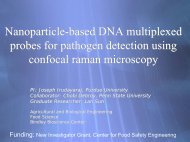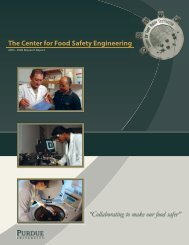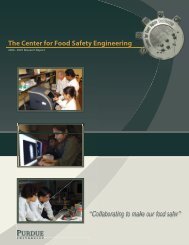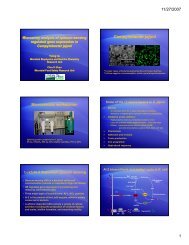BhuniaOptical biosensors <strong>for</strong> food pathogen detectionInvestigator: Arun Bhunia (Department of <strong>Food</strong> Science)Project RationaleThe ability of biosensors to detect the presence of pathogensor toxins is critical to ensure product safety. Biosensorsemploying specifi c antibodies are being widely used andshown to be effective. Our goal was to develop a fi ber opticsensor using antibodies <strong>for</strong> detecting foodborne pathogens,including Listeria monocytogenes, Escherichia coli O157:H7,and Salmonella Enteritidis. We developed a fi ber optic sensor<strong>for</strong> L. monocytogenes and E. coli O157:H7. We also developeda sensitive and specifi c fi ber optic detection assay <strong>for</strong> S.Enteritidis in poultry. The assay was compared to time-resolvedimmunofl uorescence (TRF) <strong>for</strong> confi rmation. An effi cient multipathogenarray using a fl ow-through immobilization protocol wasalso developed <strong>for</strong> detecting L. monocytogenes, E .coli, and S.Enteritidis. Pilot studies are underway to analyze the bindingeffi ciencies of an antibody-pathogen complex using selectedsurface chemistries in order to gain a better understanding of themolecular nature of these interactions. This approach will enableus to increase sensitivity and specifi city of binding on the sensor.Project HighlightsWe obtained the antibodies required to detect multiple pathogensusing a fi ber optic sensor. The antibodies were labeled withfl uorophor (Alexa-Fluor) and thoroughly characterized accordingto their reaction patterns to target pathogens when grown on amulti-pathogen selective enrichment broth, SEL (Salmonella,E. coli, and Listeria). Initial experimental trials indicate that wecan detect these three pathogens simultaneously using a fi beroptic sensor. Cross-reactions with heterologous bacteria wereminimal.Project Objectives• Develop and evaluate an antibody-coupled fi ber opticbiosensor [ANALYTE 2000] <strong>for</strong> detecting S. Enteritidis.• Develop an effi cient multi-pathogen array using a fi beroptic biosensor. This requires screening and identifyingmonoclonal and polyclonal antibodies, developed inour laboratory, <strong>for</strong> L. monocytogenes, E. coli O157:H7,and S. Enteritidis, and developing effi cient surfacechemistry protocols <strong>for</strong> evaluating and quantifyingthe binding interactions of an antibody-pathogencomplex on the surface of a fi ber optic sensor.4<strong>Center</strong> <strong>for</strong> <strong>Food</strong> <strong>Safety</strong> <strong>Engineering</strong>“The ability of biosensors to detect the presence of pathogensor toxins is critical to ensure product safety.”
Bhunia, Hirleman and RobinsonOptical <strong>for</strong>ward scattering <strong>for</strong> bacterial colonydifferentiation and identificationInvestigators: Arun Bhunia (Department of <strong>Food</strong> Science), E. Daniel. Hirleman (School of Mechanical<strong>Engineering</strong>), J. Paul Robinson (Weldon School of Biomedical <strong>Engineering</strong>)Project RationaleThe <strong>Center</strong>s <strong>for</strong> Disease Control and Prevention (CDC)estimates that 76 million people get sick, more than 300,000 arehospitalized, and 5,000 Americans die each year from foodbornepathogen infections. Preventing foodborne illnesses remainsa major public health challenge. Listeria monocytogenes,Escherichia coli, and Salmonella are three major foodbornepathogens of concern in the U.S. L. monocytogenes, alongwith Salmonella and Toxoplasma, are responsible <strong>for</strong> morethan 75 percent of the foodborne diseases and 1,500 deathsevery year compared to the other known pathogens. There hasbeen an increase in foodborne illnesses, multiple outbreaks,product recalls, and loss of lives as a result of the associationwith pathogens in processed, ready-to-eat food. Bacterialcontamination in food not only places the public at risk, it iscostly to companies due to loss of production time, productrecalls, and liability.For detecting and evaluating foods contaminated with L.monocytogenes or E. coli, the USDA/FSIS recommends initialenrichment and subsequent plating on a selective agar medium,which is often followed by identifi cation procedures. Theseprocedures are time-consuming, lasting more than fi ve to sevendays. The present industrial demand is to increase the speedof detection, decrease economical losses, and minimize publichealth concerns. Our main objective was to develop a simpleoptical light scattering sensory method to reduce the time toidentify pathogenic bacteria after plating.• Acquire scatter images of colonies of selectfoodborne bacterial, including pathogens.• Analyze bacterial colonies of different foodbornebacteria on non-selective and selective agar media.• Validate the technology by using both inherentlycontaminated food samples and samples that havebeen contaminated with selected pathogens.• Analyze cellular composition, cell arrangement,refractive index ,and colony contents usingelectron microscopy, FT-IR or GC-MS.• Analyze the scatter signal images using “standard featureextraction” and “moments of shape analysis” methods.Project HighlightsThe most signifi cant accomplishment of fi scal year 2007-2008was the design of an automated BARDOT system and relatedalgorithm. This system, including hardware and software, wasredesigned and redeveloped, and a colony counter and locatorwere constructed to provide colony counts <strong>for</strong> each plate. Toachieve that, we added a pair of illumination lights and a CCD(cooled coupled device) camera so that automatic colony countsand the precise location of each colony are visible on a computermonitor. The automated BARDOT system prototype (which wasmanufactured by the local company En’Urga) incorporates thecolony locator (which locates a colony via a line scanner), the<strong>for</strong>ward-scatterometer, and an automated classifi cation packageinto a stand-alone system.Project Objectives• Design and develop a prototype of a fully automatedBActeria Rapid Detection using Optical scatteringTechnology (BARDOT) system to locate, capture,and classify foodborne pathogenic bacteria.“The most signifi cant accomplishment ... was the design of anautomated BARDOT system and related algorithm.”5<strong>Center</strong> <strong>for</strong> <strong>Food</strong> <strong>Safety</strong> <strong>Engineering</strong>












